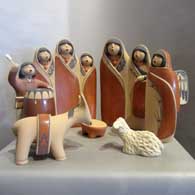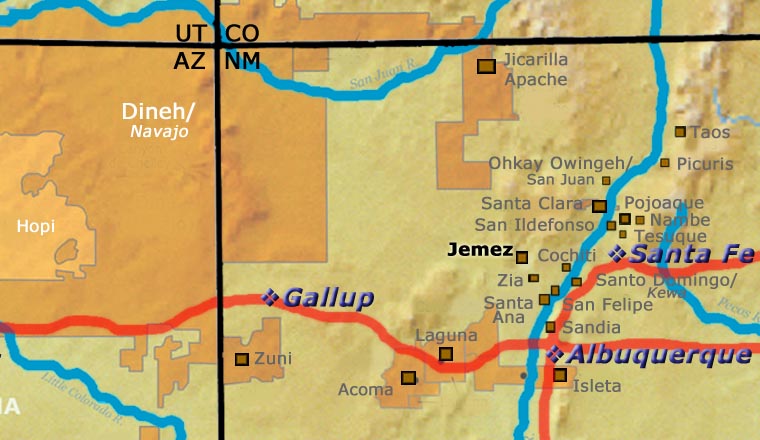
Maxine Toya
Jemez

The daughter of famous Jemez Pueblo potter Marie G. Romero, Maxine grew up surrounded by some of the most accomplished of today's Jemez potters. Among the potters in her family: Laura Gachupin, Persingula Gachupin, Bertha Gachupin, Virginia Ponca Fragua and now, Maxine's children: Camilla and Dominique.
Maxine has been producing pottery since she was 20 years old and over the years has earned numerous First, Second and Third Place awards in shows at the Eiteljorg Museum of American Indians and Western Art in Indianapolis and the Santa Fe Indian Market. She has also earned awards for Best in Pottery Division and for Most Creative Design.
Her favorite shapes to make are clay sculptures, large singular figures as seen in her famed nativity sets. Her nativities offer beautifully polished robes and peaceful and serene human and animal faces. She also usually decorates her pieces with traditional Jemez designs.
She told us she originally got much of her inspiration from Apache sculptor Allan Houser. She says she also gets inspiration from her mother and from the works of other potters.
Maxine tells us she loves the feel of clay: "It is so alive and it wants to speak through me." Working with clay is her favorite form of therapy.
Some Exhibits that Featured Maxine's Work
- Gifts from the Community. Heard Museum West. Surprise, Arizona. April 12, 2008 - October 12, 2008
- Images, Artists, Styles: Recent Acquisitions from the Heard Museum Collection. Heard Museum North. Scottsdale, Arizona. July - December 2001
- Bridges and Boundaries (Brucken und Abgrenungen). Peiper-Riegraf Gallery. Frankfurt, Germany. October 9, 1995 - November 6, 1995. Note: artists include David Bradley, Rick Bartow, Bob Haozous, Edgar Heap of Birds, Delbridge Honanie, David Johns, Mike Kabotie, Linda Lomahaftewa, Jean LaMarr, Dan Namingha, Jaune Quick-to-see Smith, Darren Vigil-Gray, Maxine Toya and Emmi Whitehorse
Some Awards Won by Maxine
- 2024 Santa Fe Indian Market, Classification IIB, Category 607 - Boundary, First Place, shared with Dominique Toya and Sergio Youngblood Lugo
- 2024 Santa Fe Indian Market, Classification IIB, Category 606 - Traditional Storytellers, First Place
- 2023 Santa Fe Indian Market, Classification IIB, Category 605 - Figures/Manas, First Place
- 2022 Heard Museum Guild Indian Fair & Market: Honorable Mention for Classification II - Pottery, awarded for collaborative artwork with Dominique Toya. Awarded for artwork: Untitled
- 2019 Santa Fe Indian Market, Classification II - Pottery, Division B - Traditional Painted Pottery, Category 604 - Painted polychrome pottery in the style of Jemez, Zia, Santa Ana, Sandia, San Felipe, Isleta, any form: Second Place shared with Dominique Toya
- 2019 Santa Fe Indian Market, Classification II - Pottery, Division B - Traditional Painted Pottery, Category 606 - Traditional storytellers, including sets: Second Place
- 2019 Heard Museum Guild Indian Arts Fair & Market, Classification II - Pottery, Division A - Painted, native clay, hand build, fired out-of-doors: First Place. Awarded for collaborative artwork with Dominique Toya: Traditional Storage Jar
- 2018 Santa Fe Indian Market, Classification II - Pottery, Division B - Traditional Painted Pottery, Category 604 - Painted polychrome pottery in the style of Jemez, Zia, Santa Ana, Sandia, San Felipe, Isleta, any form: First Place. Shared First Place with Dominique Toya
- 2018 Santa Fe Indian Market, Classification II - Pottery, Division B - Traditional Painted Pottery, Category 605 - Figures/Manas: Second Place
- 2018 Santa Fe Indian Market, Classification II - Pottery, Division B - Traditional Painted Pottery, Category 606 - Traditional storytellers, including sets: First Place
- 2017 Santa Fe Indian Market: Classification II - Pottery, Division B - Traditional, Category 606 - Traditional storytellers, including sets: Second Place
- 2017 Santa Fe Indian Market: Classification II - Pottery, Division B - Traditional, Category 606 - Traditional storytellers, including sets: Honorable Mention. August 2017
- 2017 Heard Museum Guild Indian Fair & Market, Classification II - Pottery, Division D - Figurative, Native Clay, Hand Built: Second Place. Awarded for collaborative artwork with Nancy Youngblood: "Margaret Tafoya"
- 2012 Heard Museum Guild Indian Fair & Market, Classification Honorable Mention.II - Pottery, Division A - Traditional, native clay, hand built, painted: Honorable Mention. Awarded for collaborative artwork "Generation" with Dominique Toya
- 2004 Santa Fe Indian Market, Classification II - Pottery, Division F - Traditional pottery, painted designs on matte or semi-matte surface, all forms except jars, Category 1306 - Storyteller: First Place
- 2004 Santa Fe Indian Market, Classification II - Pottery, Division G - Non-traditional pottery, using traditional materials and techniques, any form or design, Category 1405 - Figures, all one piece, can include storyteller bowls: Second Place
- 2004 Santa Fe Indian Market, Classification II - Division H - Non-traditional pottery using traditional materials and techniques with non-traditional decorative elements, Category 1504 - Single figures: Second Place
- 2000 Santa Fe Indian Market, Classification II - Pottery, Division F - traditional pottery, all forms except jars, Category 1310 - storytellers (all one piece): First Place
- 1978 Heard Museum Guild Indian Arts and Crafts Exhibit, Classification VII - Pottery, Division B - Contemporary: Honorable Mention. Awarded for artwork: Kiva with clowns
100 West San Francisco Street, Santa Fe, New Mexico 87501
(505) 986-1234 - www.andreafisherpottery.com - All Rights Reserved

Jemez Pueblo

Ruins of San Jose de las Jemez Mission
As the drought in the Four Corners region deepened in the late 1200s, several clans of Towa-speaking people migrated southeastward from the Four Corners area to the Canyon de San Diego area the southern Jemez mountains, in what is now north-central New Mexico. Other clans of Towa-speaking people migrated southwest and settled in the Jeddito Wash area, below Antelope Mesa and southeast of Hopi First Mesa, in what is now northeastern Arizona. The migrations began in earnest in the mid 1200s and were mostly complete by the mid 1300s.
Archaeologist Jesse Walter Fewkes argues that potsherds found in the vicinity of the ruin at Sikyátki (near the foot of Hopi First Mesa) speak to the strong influence of earlier Towa-speaking potters on what became "Sikyátki Polychrome" pottery (Sikyátki was a village at the foot of First Mesa, destroyed before the first Hopi contact with the Spanish in 1540). Fewkes maintained that Sikyátki Polychrome pottery was the finest ceramic ware ever made in prehistoric North America.
Francisco de Coronado and his men arrived in the Jemez Mountains of Nuevo Mexico in 1539. By then the Jemez people had built several large masonry villages among the canyons and on some high ridges in the area. Their population was estimated at about 30,000 and they were among the largest and most powerful tribes in northern New Mexico. Some of their pueblos reached five stories high and contained as many as 3,000 rooms.
Because of the nature of the landscape they inhabited, growing food was very hard. So the Jemez became traders, too, and their people traded goods all over the Southwest and northern Mexico.
The arrival of the Spanish was disastrous for the Jemez and they resisted the Spanish with all their might. That led to many atrocities against the tribe until they rose up in the Pueblo Revolt of 1680 and evicted the Spanish from northern New Mexico. With the Spanish gone, the Jemez destroyed much of what they had built on Jemez land. Then they concentrated on preparing themselves for the eventual return of the hated priests and the Spanish military.
The Spanish returned in 1692 and their efforts to retake northern New Mexico bogged down as the Jemez fought them doggedly for four years. In 1696 many Jemez came together, killed a Franciscan missionary and then fled to join their distant relatives in the Jeddito Wash area. They remained at Jeddito Wash for several years before returning to the Jemez Mountains. As a result of that long ago contact, there are still strong ties between the Jemez and their cousins on Navajo territory at Jeddito. On their return to the Jemez Mountains, the people built the pueblo they now live in (Walatowa: The Place) and made peace with the Spanish authorities.
Some of the Jemez people had been making a type of plainware pottery (simple, undecorated, utilitarian) when they were still in the Four Corners area, while others had developed a distinctive type of black-on-white pottery. In moving to the Jemez Mountains, they brought their knowledge and techniques with them but had to adapt to the different materials available to work with. Over time, the Jemez got better in their agricultural practices and began trading agricultural goods to the people of Zia Pueblo in return for pottery. By the mid-1700s, the Jemez people were producing almost no pottery.
East of what is now Santa Fe is where the ruins of Cicuyé (Pecos) Pueblo are found. Cicuyé was a large pueblo housing up to 2,000 people at its height. The people of Cicuyé, and some in the northern Galisteo Basin, were the only other speakers of the Towa language in New Mexico. When that area fell on increasingly hard times (Apache and Comanche raids, European diseases, drought), Cicuyé was finally abandoned in 1838 when the last 17 residents moved to Jemez. The Governor of Jemez welcomed them and allowed them to retain many of their Cicuyé tribal offices (governorship and all). Descendants of former Cicuyé families still return to the site of their ancestral home every year to perform religious ceremonies in honor of their ancestors.
When general American interest in Puebloan pottery started to take off in the 1960s, the people of Jemez sought to recover that lost heritage. Today, the practice of traditional pottery-making is very much alive and well among the Jemez.
The focus of Jemez pottery today has mostly turned to the making of storytellers, nativities and other figures. Figures are an art form that now accounts for more than three-quarters of their pottery production.
Storytellers are usually grandparent figures with the figures of children attached to their bodies. The grandparents are pictured singing tribal songs and oral histories to their descendants. While this visual representation was first created at Cochiti Pueblo (a site in close geographical proximity to Jemez Pueblo) in the early 1960s by Helen Cordero, it speaks to the relationship between grandparents and grandchildren of every culture. Nativities, corn maidens, singing angels and many different animal forms are also popular among the potters of Jemez.
The pottery vessels made at Jemez Pueblo today are generally not black-on-white. Instead, the potters have adopted many colors, styles and techniques from other pueblos to the point where Jemez potters no longer have one distinct style of their own beyond that which stems naturally from the materials they themselves acquire from their surroundings: it doesn't matter what the shape or design is, the clay itself says uniquely "Jemez."
100 West San Francisco Street, Santa Fe, New Mexico 87501
(505) 986-1234 - www.andreafisherpottery.com - All Rights Reserved
